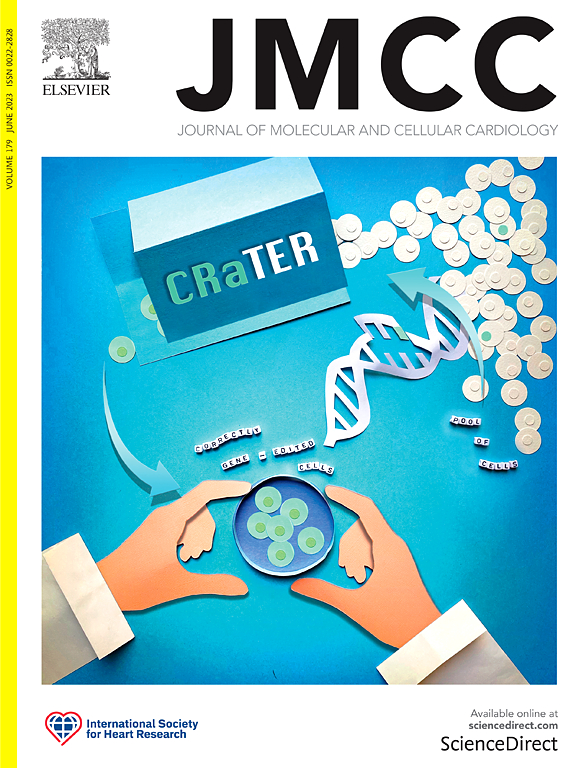GDF10 promotes rodent cardiomyocyte maturation during the postnatal period
IF 4.7
2区 医学
Q1 CARDIAC & CARDIOVASCULAR SYSTEMS
引用次数: 0
Abstract
Cardiomyocytes and cardiac fibroblasts undergo coordinated maturation after birth, and cardiac fibroblasts are required for postnatal cardiomyocyte maturation in mice. Here, we investigate the role of cardiac fibroblast-expressed Growth Differentiation Factor 10 (GDF10) in postnatal heart development. In neonatal mice, Gdf10 is expressed specifically in cardiac fibroblasts, with its highest expression coincident with the onset of cardiomyocyte cell cycle arrest and transition to hypertrophic growth. In neonatal rat ventricular myocyte (NRVM) cultures, GDF10 treatment promotes cardiomyocyte maturation indicated by increased binucleation, downregulation of cell cycle progression genes, and upregulation of cell cycle inhibitor genes. GDF10 treatment leads to an increase in cardiomyocyte cell size, together with increased expression of mature sarcomeric protein isoforms and decreased expression of fetal cardiac genes. RNAsequencing of GDF10-treated NRVM shows an increase in the expression of genes related to myocardial maturation, including upregulation of sodium and potassium channel genes. In vivo, loss of Gdf10 leads to a delay in myocardial maturation indicated by decreased cardiomyocyte cell size and binucleation, as well as increased mitotic activity, at postnatal (P) day 7. Further, induction of mature sarcomeric protein isoform gene expression is delayed, and expression of cell cycle progression genes is prolonged. However, by P10, indicators of cardiomyocyte maturation and mitotic activity are normalized in Gdf10-null hearts relative to controls. Together, these results implicate GDF10 as a novel crosstalk mediator between cardiomyocytes and cardiac fibroblasts, which is required for appropriate timing of cardiomyocyte maturation steps including binucleation, hypertrophy, mature sarcomeric isoform gene expression, and cell cycle arrest in the postnatal period.

GDF10促进出生后啮齿类动物心肌细胞成熟。
心肌细胞和心成纤维细胞在出生后经历协调成熟,小鼠出生后心肌细胞成熟需要心成纤维细胞。在这里,我们研究了心脏成纤维细胞表达的生长分化因子10 (GDF10)在出生后心脏发育中的作用。在新生小鼠中,Gdf10在心脏成纤维细胞中特异性表达,其最高表达与心肌细胞细胞周期停滞和向肥厚生长过渡的开始一致。在新生大鼠心室肌细胞(NRVM)培养中,GDF10处理通过增加双核、下调细胞周期进展基因和上调细胞周期抑制基因来促进心肌细胞成熟。GDF10处理导致心肌细胞细胞大小增加,同时成熟肉瘤蛋白亚型表达增加,胎儿心脏基因表达减少。gdf10处理NRVM的rnas测序显示,心肌成熟相关基因的表达增加,包括钠通道和钾通道基因的上调。在体内,Gdf10的缺失导致心肌成熟的延迟,表现为心肌细胞大小和双核的减少,以及在出生后(P)第7天有丝分裂活性的增加。此外,成熟肉瘤蛋白异构体基因表达的诱导被延迟,细胞周期进展基因的表达被延长。然而,通过P10,相对于对照组,在gdf10缺失的心脏中,心肌细胞成熟和有丝分裂活性指标正常化。总之,这些结果表明GDF10是心肌细胞和心脏成纤维细胞之间的一种新的串扰介质,它是心肌细胞成熟步骤的适当时机所必需的,包括双核、肥大、成熟的肉瘤同种异构体基因表达和出生后细胞周期停滞。
本文章由计算机程序翻译,如有差异,请以英文原文为准。
求助全文
约1分钟内获得全文
求助全文
来源期刊
CiteScore
10.70
自引率
0.00%
发文量
171
审稿时长
42 days
期刊介绍:
The Journal of Molecular and Cellular Cardiology publishes work advancing knowledge of the mechanisms responsible for both normal and diseased cardiovascular function. To this end papers are published in all relevant areas. These include (but are not limited to): structural biology; genetics; proteomics; morphology; stem cells; molecular biology; metabolism; biophysics; bioengineering; computational modeling and systems analysis; electrophysiology; pharmacology and physiology. Papers are encouraged with both basic and translational approaches. The journal is directed not only to basic scientists but also to clinical cardiologists who wish to follow the rapidly advancing frontiers of basic knowledge of the heart and circulation.

 求助内容:
求助内容: 应助结果提醒方式:
应助结果提醒方式:


